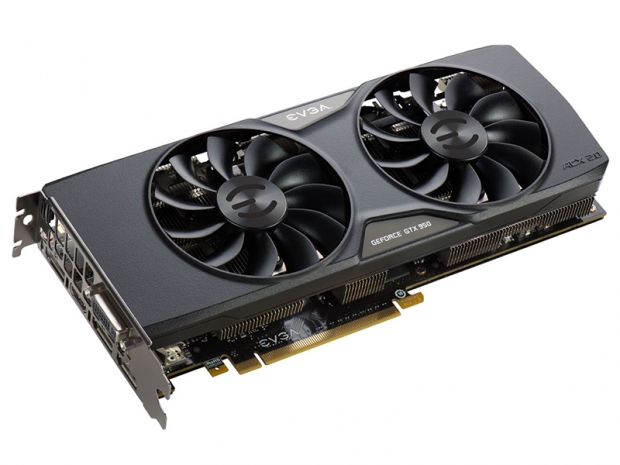Index
Review: Price is too high, but we blame Nvidia
EVGA’s factory-overclocked FTW card gives pleasant and quiet 1080p gaming but it is a bit on the pricey side.
Our test sample, dubbed the GTX 950 FTW (part number 02G-P4-2958-KR) came from EVGA with the company’s trademark ACX 2.0 dual-fan cooler. Its high factory overclock sets the GPU Base clock to 1203MHz and boost clock to 1405MHz. Reference clocks are 1024MHz (Base ) and 1188MHz (Boost). With such high factory-overclock, the GTX 950 FTW gets considerable performance improvement. Our result tables show the factory overclock helps in playing at 1080p resolution with high in-game details enabled.
The Geforce GTX 950 is Nvidia’s second mainstream graphics card based on the new Maxwell architecture. Maxwell is a synonym for great combination of performance, power-draw, and fan-noise, and it comes with DirectX 12 support. The GTX 950 graphics card is based on silicon codenamed GM206. This GPU is used for the GTX 960 graphics card, but Nvidia has disabled some parts of the GPU to create the GTX 950.
Nvidia launched the Geforce GTX 960 describing it as a “sweet spot” graphics card. Traditionally Nvidia’s “sweet spot” cards are 60-series models such as the GTX 460, 560, 660, and 760. They offer a good price/performance ratio and the current generation can run most titles at 1080p with high detail settings. The GTX 960 is available for about €190; the card uses fully enabled GM206 GPU.
The GTX 950 is made for gamers on budget. The suggested MSRP including VAT for the GTX 950 is €169 (Germany) while in most other EU countries the prices starts from €179.
The GM206 GPU used in the GTX 950 comes with 768 CUDA cores compared to 1024 CUDA cores available in the GTX 960. Both cards have 2GB of GDDR5 memory combined with 128-bit memory interface. The latter gains its performance advantage from higher number of CUDA cores and higher clocks. The GPU Base clock for the GTX 950 is set at 1024MHz compared with 1127MHz on the GTX 960. The memory clock for the GTX 950 is set at 1650MHz (6600MHz effective GDDR5) while memory on the GTX 960 works at 1750MHz (7000MHz effective GDDR5). Resulting bandwidths are 105.6 GB/s and 112 GB/s respectively.
The GTX 950 FTW card uses custom PCB with 256mm length, which is longer than 210mm long reference PCB (there will be no reference-designed card, as all Nvidia partners will use their own custom designs). The longer PCB makes it possible to use ACX 2.0 cooler with bigger dissipation area. Next image shows the GTX 950 FTW ACX 2.0 graphics card which manages to provide both good performance and silent work.
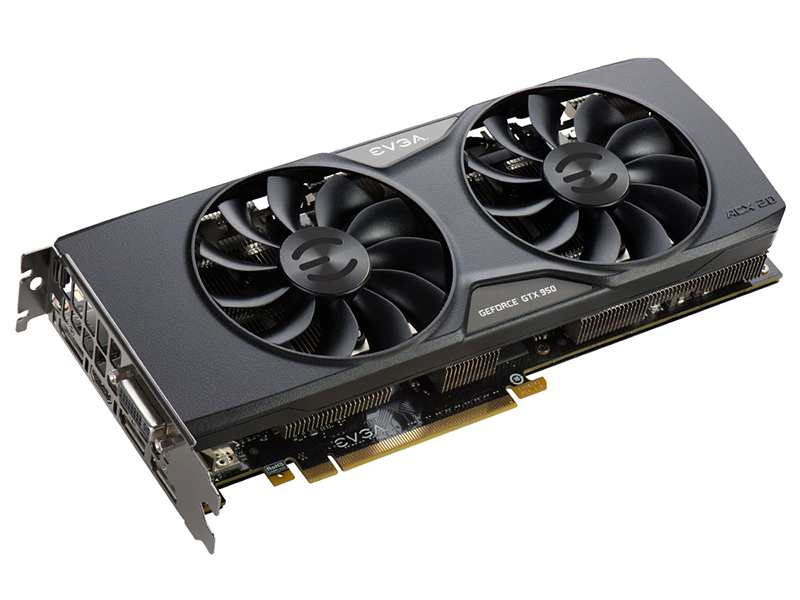
EVGA did not change the memory clock. The GPUZ screenshot below confirms the clocks.
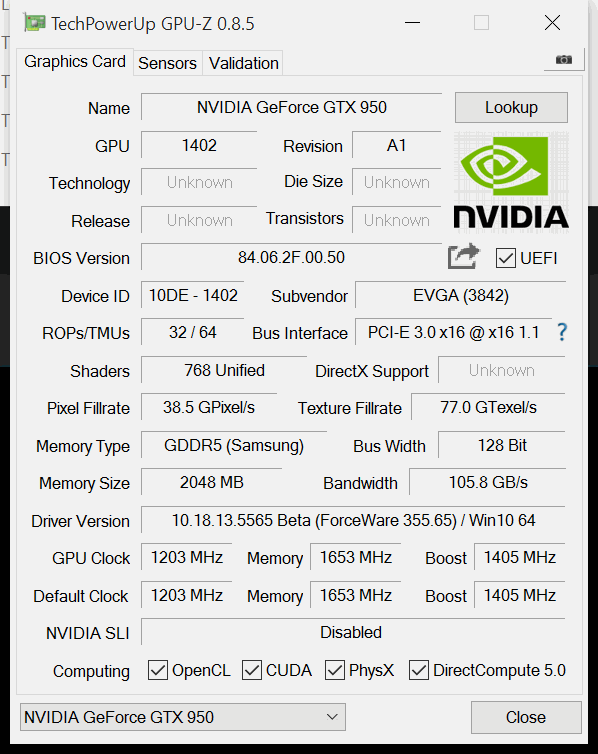
The typical boost clock speed is 1405MHz. The boost clock speed is based on the average Geforce GTX 950 card running a wide variety of games and applications. Note the boost clock will vary from game-to-game depending on system conditions.
With the arrival of the Geforce GTX 950, Nvidia’s Geforce GTX lineup consists of the following GPUs:
- GeForce GTX TITAN X
- GeForce GTX 980 Ti
- GeForce GTX 980
- GeForce GTX 970
- GeForce GTX 960
- GeForce GTX 950
- GeForce GTX 750 Ti
EVGA extends its lineup with four GTX 950 graphics cards. The GTX 950 FTW is the among the fastest factory overclocked GTX 950 cards. If the ACX 2.0 dual-fan cooler is too long for you, there is GTX 950 SC with single fan cooler.
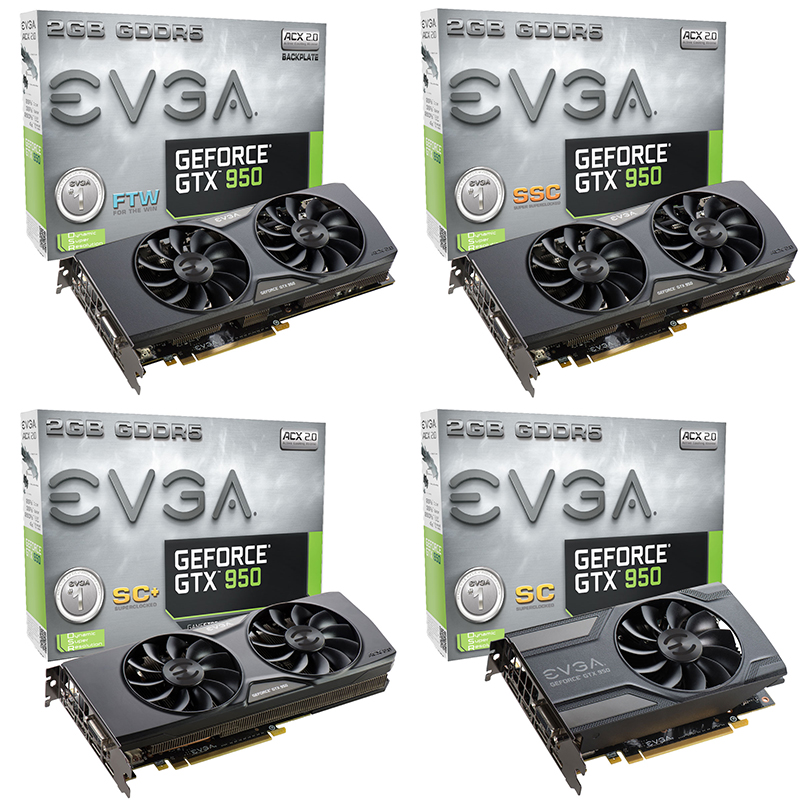

The GM206 Pro GPU
The GM206 GPU used in the Geforce GTX 960/ GTX 950 features all the key architectural innovations first introduced in the Geforce GTX 980. Maxwell GPUs feature a new SM design that’s been tailored to improve efficiency.
The Maxwell SMM is partitioned into four distinct 32-CUDA core processing blocks (128 CUDA cores total per SMM), each with its own dedicated resources for scheduling and instruction buffering. By giving each processing block its own dedicated resources for instruction scheduling and dispatch, Nvidia fully uses the GPU’s CUDA cores more often. This improves workload efficiency and reduces power that usually goes to waste.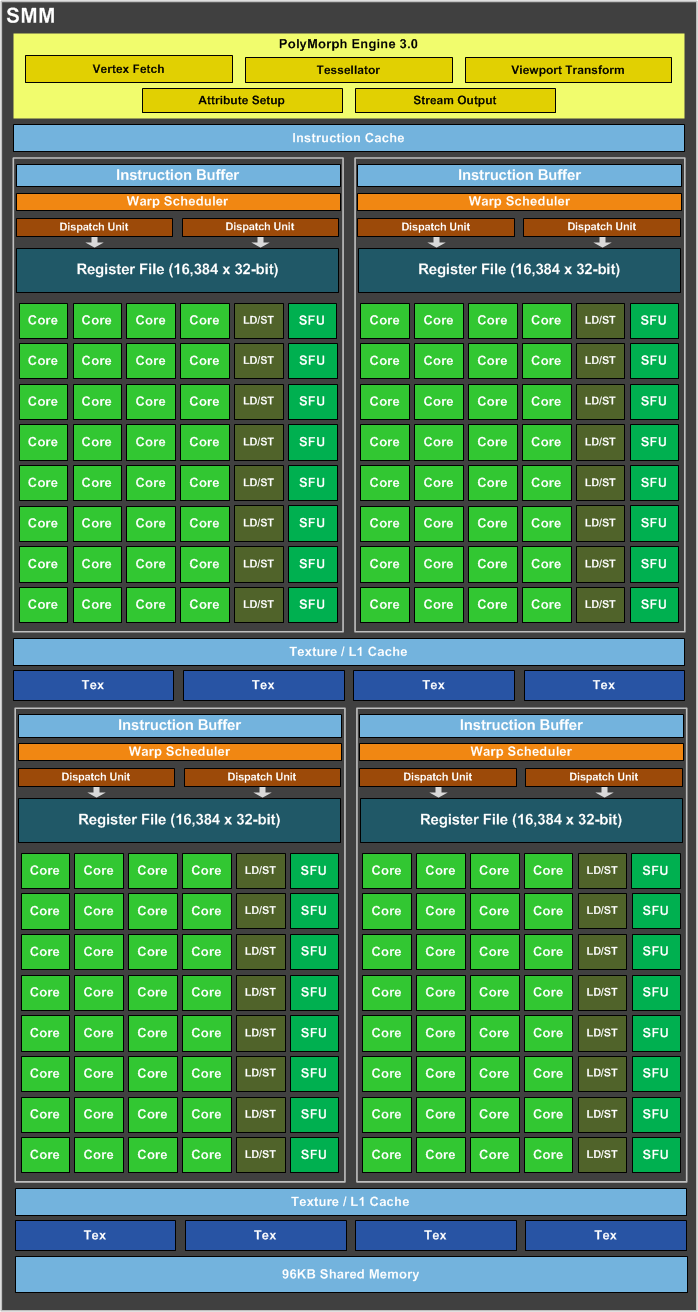
The GM206 GPU used in the Geforce GTX 950 ships with 6 SMM units and is composed of 768 CUDA cores in total, while 48 texture units are available for texture processing (compared to 1024 CUDA cores in GTX 960).
To improve the efficiency of the GPU’s onboard caches, Nvidia has made several changes to the cache hierarchy in Maxwell. Each of GM206’s SMM units features its own dedicated 96KB shared memory, while the L1/texture caching functions are combined into a 24KB pool of memory per pair of processing blocks (48KB per SMM). Previous generation Kepler GPUs had a smaller 64KB shared memory function that was shared as L1 cache.
GM206 ships with 1MB of L2 cache that’s shared across the GPU. With more built-in cache, fewer requests to graphics DRAM are needed, this improves performance and reduces power consumption. In addition, Nvidia’s third-generation delta colour compression engine offers new modes for colour compression, allowing the GPU to more effectively use its available memory bandwidth. The GM206 uses roughly 25% fewer bytes per frame compared to prior generation Kepler GPUs.
Because of these changes, each GM206 CUDA core can deliver roughly 1.4x more performance per core compared to a GK106 Kepler CUDA core (the direct predecessor of GM206), and 2x the performance per watt.
The memory subsystem of Geforce GTX 950/ GTX 960 consists of two 64-bit memory controllers (128-bit) with 2GB of GDDR5 memory. The GTX 950’s memory is running at 6.6GHz effective memory clock, while the GTX 960 sets clock at 7GHz. Thanks to the lossless texture compression technology that reduces memory bandwidth usage both GTX 950 and GTX 960 should score good at 1080p resolution.
GM206 GPU supports all the key innovations first introduced in Geforce GTX 980, including support for DirectX 12 API with Feature Level 12.1. DirectX 12 offers a lower level access to hardware and it promises better use of both CPU and GPU. Among DirectX 12 features are conservative raster and raster ordered views.
All GM2xx Maxwell GPUs support volume tiled resources. This feature can allow game developers to produce higher fidelity graphics with less memory. Owners of GTX 950 should benefit from this technology since the card implements only 128-bit memory interface running at 6.6GHz effective memory clock, and is outfitted with 32 ROPs and 2GB of GDDR5 memory.
New features introduced with Maxwell include as real-time voxel illumination, MFAA (multi-frame sampled anti-aliasing), Dynamic Super-Resolution (DSR), Turf Effects, VR Direct, PhysX Flex, G-Sync and ShadowPlay.
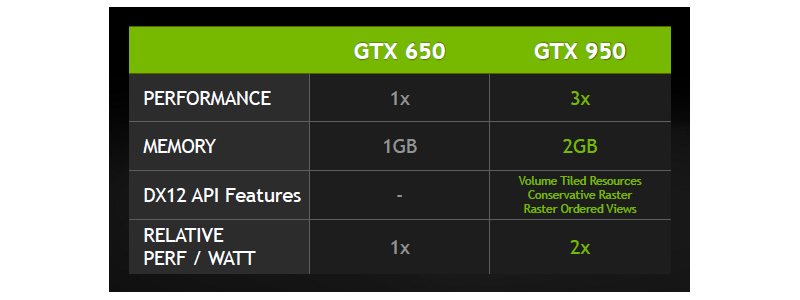
MFAA for example can be used to provide image quality similar to 4xMSAA, at a cost that’s closer to 2xMSAA. Nvidia’s G-Sync display technology delivers the smooth and fast gaming experience for gamers, free from screen tearing, VSync input lag, and display-induced stuttering (similar to what you can have with FreeSync on AMD graphics cards).
Both Nvidia and AMD are building an ecosystem around their GPUs that’s meant to provide the users with lot more than just advanced gaming features. Nvidia police is driven by three key principles: offer the most advanced technology for their users, provide the best gaming experiences, and deliver more ways to play than anywhere else.
With Geforce Experience, gamers don’t have to sort through the myriad of graphics settings many games ship with. With the click of a button, Geforce Experience automatically decides the right game settings for over 250 top games to deliver best performance for your particular GPU. We think this is a good feature especially for the owners of a GTX 950 and similar graphics cards which are not powerful enough to play games at all different graphics detail levels.
ShadowPlay allows gamers to share their favourite gaming moments with the world. You can record at up to 4K resolution at 60 fps, and even broadcast directly to Twitch. With Nvidia GameStream technology, Geforce GTX gamers can stream games from their PC to their Shield device.
And new Geforce Experience features launching with the GTX 950 offers more ways for gamers to play with their friends. GameStream Co-Op allows gamers to stream their games over the internet to a friend and play with them cooperatively. You can invite friends to join the game by either sending them an email invite, or copying and pasting an invite URL into a chat program. Currently you need Chrome web browser for this to work. It supports DirectX 9 or higher games running in fullscreen exclusive mode. Nvidia recommends at least 7Mbps upstream and downstream for both the host and guest PCs respectively.
To make the recording and broadcasting functions more accessible to Geforce Experience users, the new version of the software integrates a new in-game share overlay menu. With a press of a hotkey (Alt+Z), users can launch the new in-game overlay.
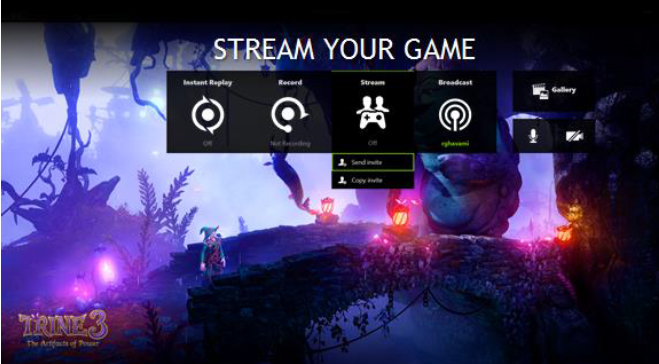
The Packaging
The box is pretty nice. It is not too big, it's just the right size.
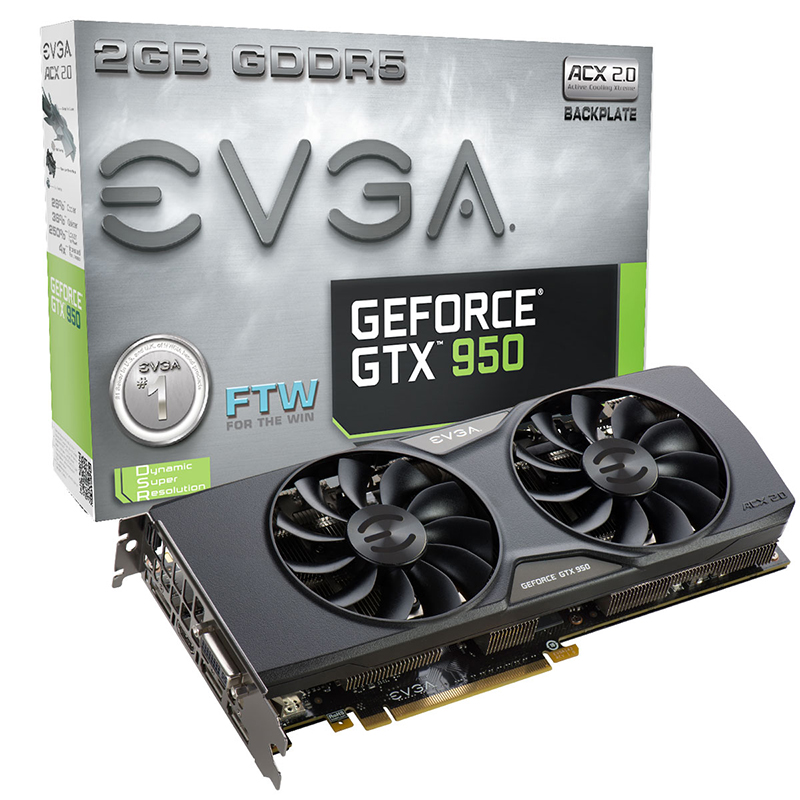
In the box you’ll find:
- EVGA Full Size Poster
- A User Guide and Quick Installation Guide
- A sticker set (Enthusiast Built)
- Driver DVD
- A small note about PCIE 3 compatibility
- EVGA Case Badge
- DVI to VGA Dongle
- 1x 6-pin to 8-pin Power Adapter (the card uses non-reference 8-pin power connector)
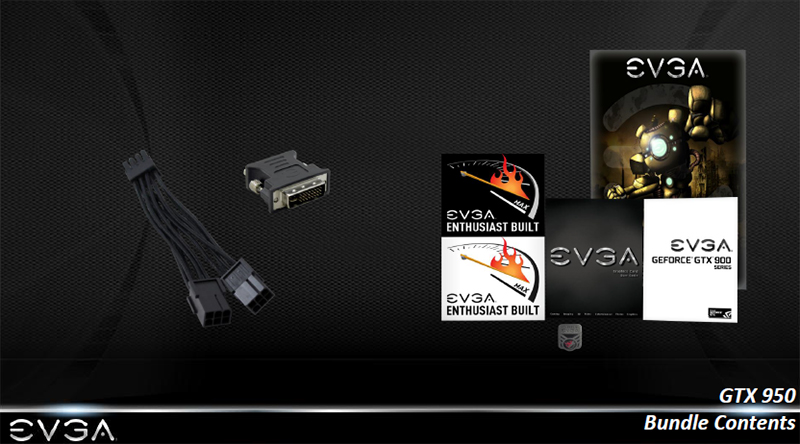
A closer look at EVGA FTW
The dual-slot ACX 2.0 cooler looks like it should have no trouble keeping the temperatures and noise emissions in check despite a high factory overclock. The GTX 950 FTW comes with 179MHz GPU overclock, but the GM206 GPU is small chip and it has only 90W TDP. We had a chance to test the ACX 2.0 cooler on the GTX 960 SSC and it impressed us with its low noise. We expect to see better performance on the less powerful GTX 950 FTW.

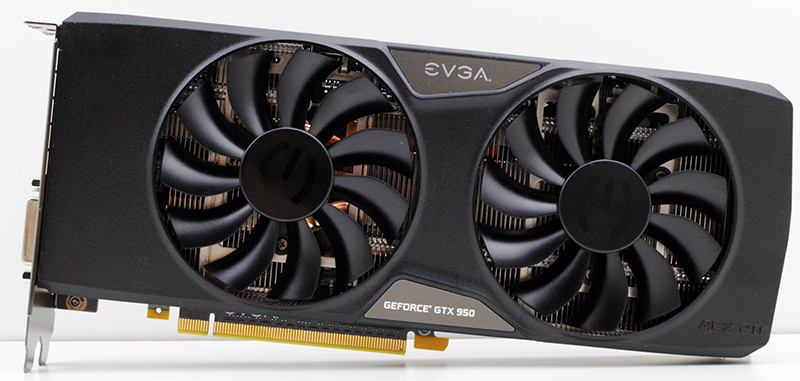
We’re talking about a dual-slot cooler with two 8.8cm fans on top. The Power Logic PLA09215B12H fan has some good features. It was chosen due to its dense, curved blade design and double ball bearing design.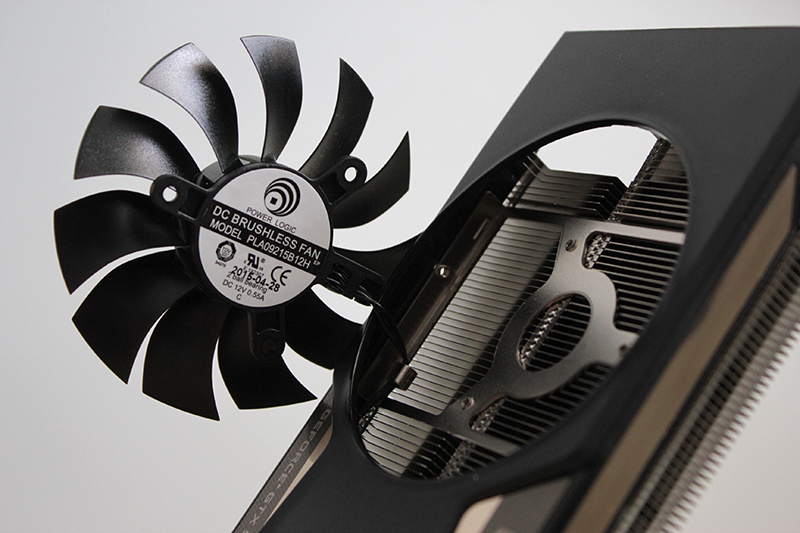
Poor blade design makes more noise but, this 9-blade fan is up to the job. EVGA says the blades are up to 700 per cent more rigid than fan blades in competing fans. This results in a 25 per cent weight decrease. These fans do live up to these claims. The fan uses a double ball bearing design. The noise produced by ball bearing designs is low, at least while they are new. As this fan uses two ball bearings it should last a bit longer and produce a less noise even after a couple of years of wear.

EVGA took an open shroud approach, where fans are positioned on top and blow directly at the heatsink. This approach means that hot air will not be vented from the chassis. Satisfactory airflow ensures the best possible cooling, but it’s nothing that a few quality intake and outtake fans won’t effectively nullify.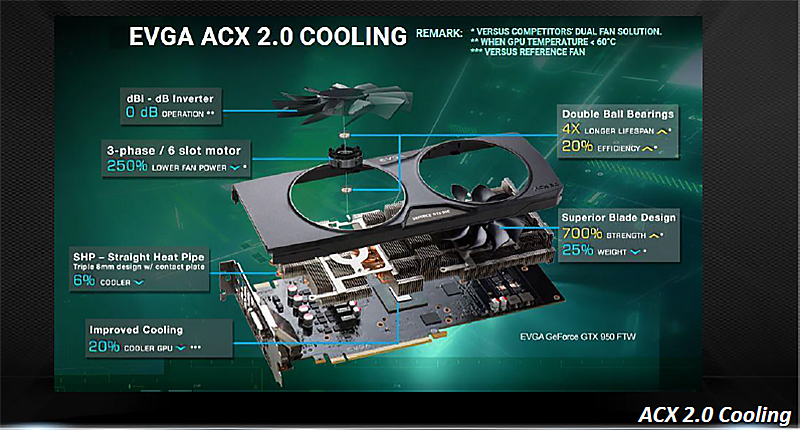
EVGA designed a special heatsink with many dissipation surfaces. Unfortunately you cannot remove the shroud from the heatsink, like on the image above. This is due to a hidden screw below the EVGA Geforce GTX 950 top label. EVGA should remove or reposition this screw and allow the user to remove the shroud easily. On the GTX 980 Ti Superclocked that we tested recently, top label as well as the FTW sign will light once the card is in use. There is no such fancy feature on the GTX 950 cards.
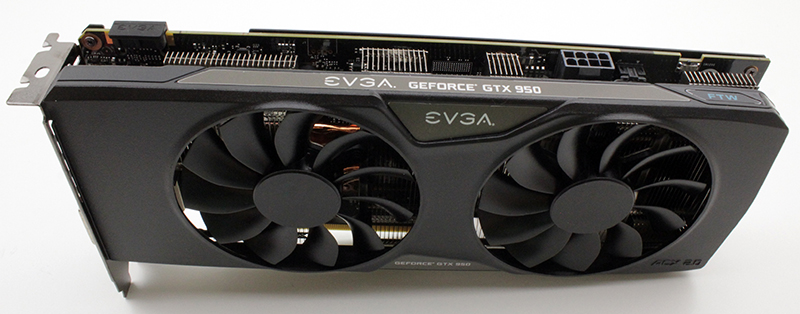
All the juice the card needs can be supplied via the PCIe connector (up to 75W) and one 6-pin power connector (up to 75W). Instead of 6-pin power connector EVGA used an 8-pin power connector (up to 150W). This is not necessary for the card with TDP of 90W, but EVGA used existing PCB and cooler designed for the GTX 960. There is no difference in real life between the two different connectors in a context of the GTX 950.
While it is not a high-end product, Nvidia still enabled SLI support on the GTX 950. With the GTX 750 Ti and GTX 650 Ti SLI this was impossible. It was supported on the GTX 650 Ti boost).
The GTX 950’s display engine supports up to four simultaneous displays at up to 5K (5120x3200) resolution or five physical displays in total. Display outputs include dual-link DVI, HDMI and DisplayPort connectors, with the number varying depending on Nvidia board partners. EVGA GTX 950 FTW comes with one dual-link DVI, one HDMI and three DisplayPort connectors. With support for HDMI 2.0, the Geforce GTX 950 can playback 4K content at 60 fps and it natively supports H.265 (HEVC) encode and decode in hardware. Protective caps are on all video out connectors.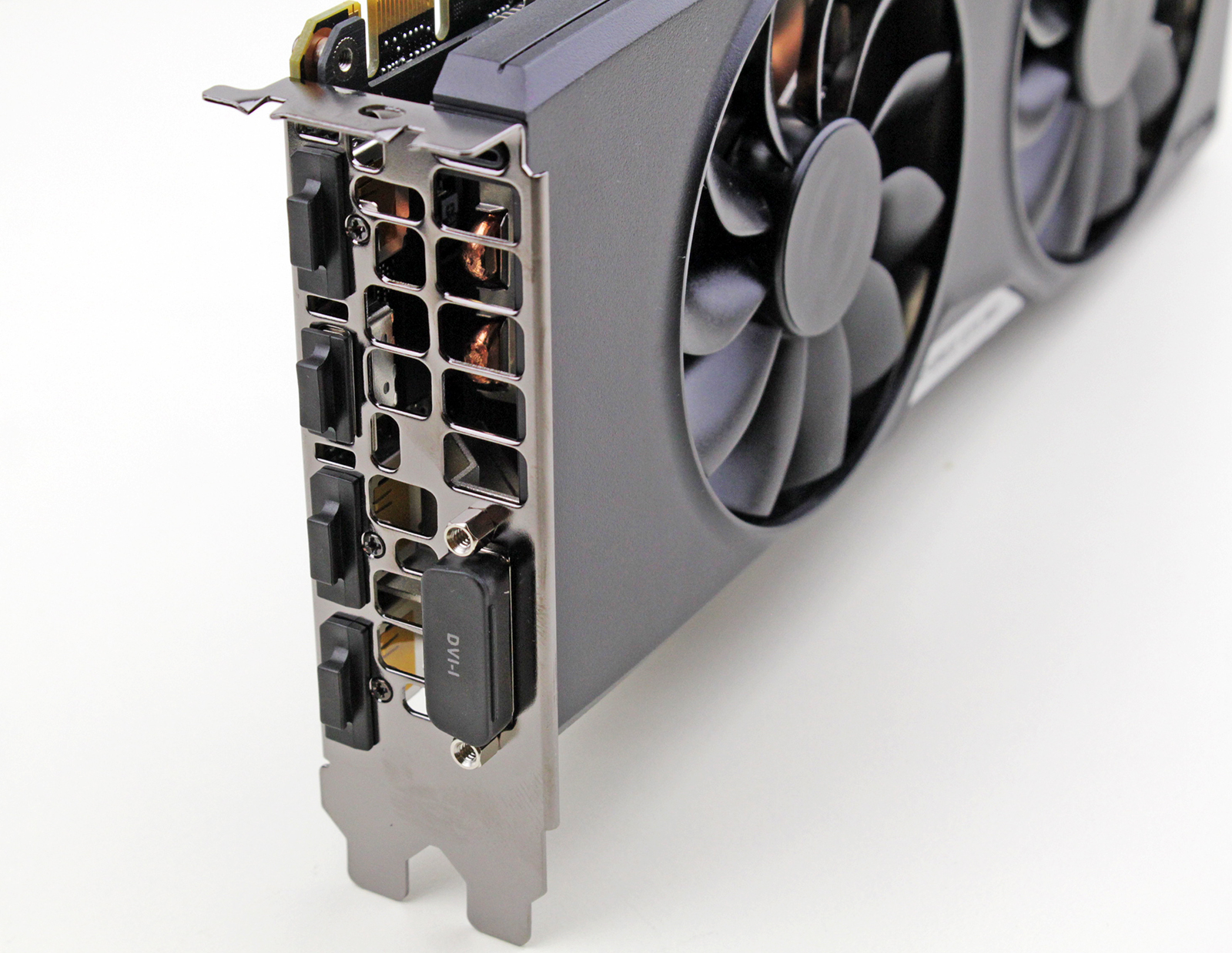
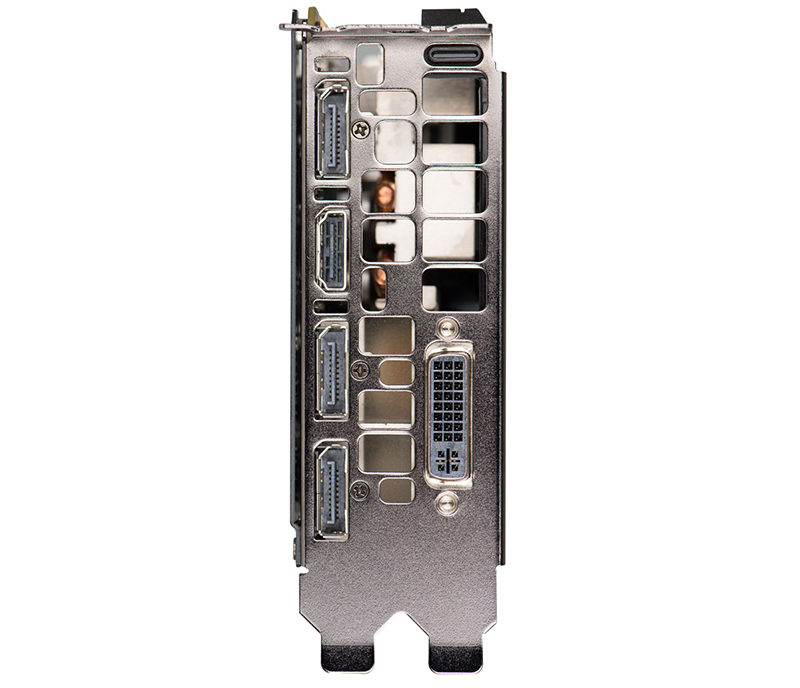
The I/O bracket doubles as an exhaust vent, helping reduce temperatures in the chassis.
The card has 2GB of GDDR5 memory, courtesy of Samsung. The chip designation is K4G41325FC-HC28. Two of four memory modules are placed on the back side of the PCB where they are covered by nice-looking backplate.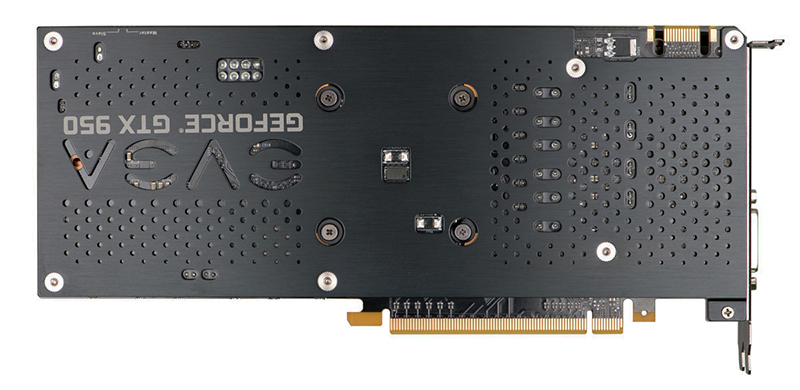
The same memory chips are used on the GTX 970 SSC and GTX 960 SSC. They are specified to run at 1750 MHz (7000 MHz GDDR5 effective) but Nvidia decided to lower the clock down to 1650MHz for the GTX 950.
Compared to GTX 960 lineup of the EVGA cards using ACX 2.0 cooler, the GTX 950 series does not come with full-size cooling plate on the front side of the PCB. You can see how it looks on the image below which shows GTX 960 SuperSC card.
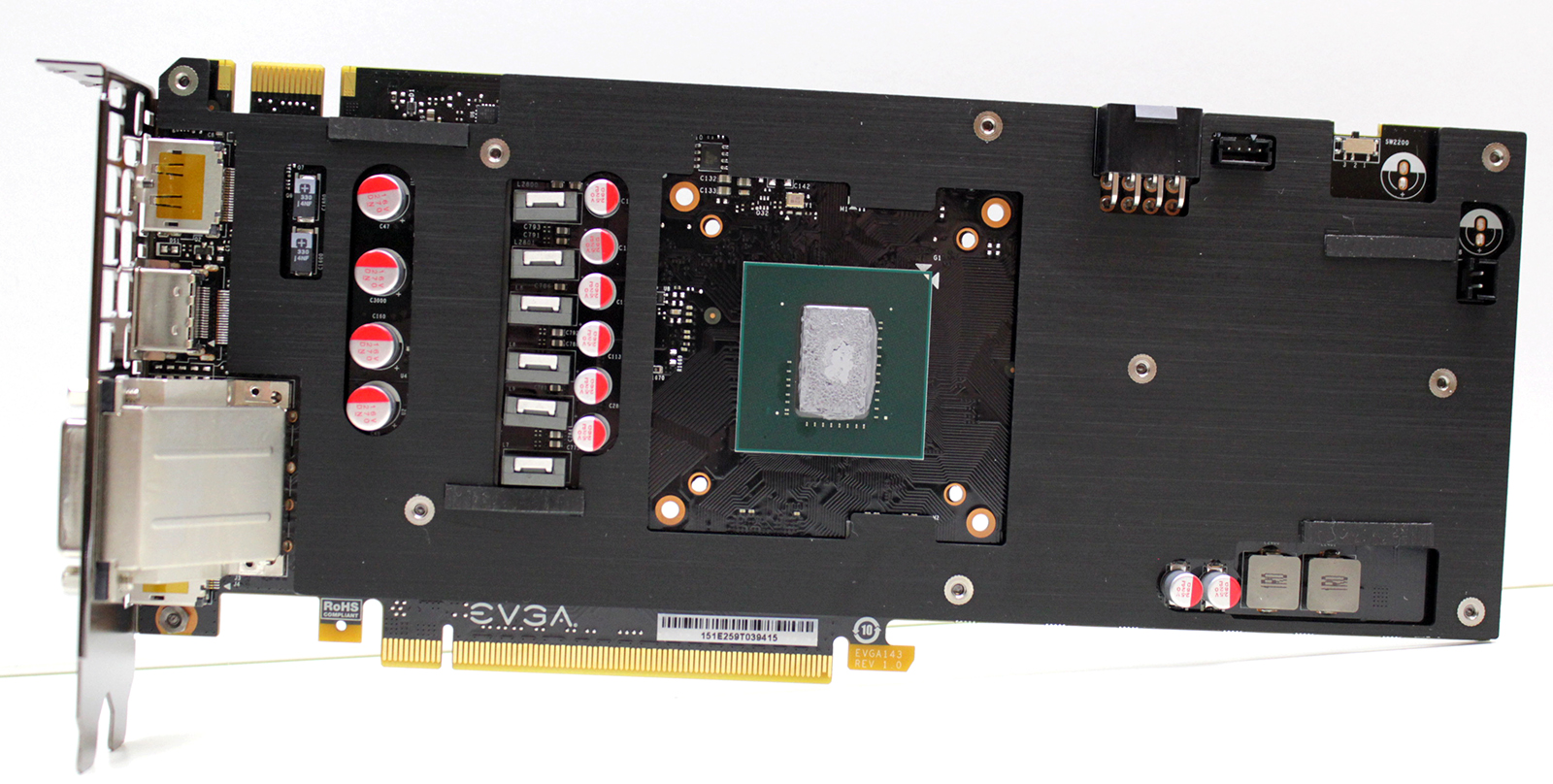
Next image shows the GTX 950 FTW card with the ACX 2.0 cooler removed.
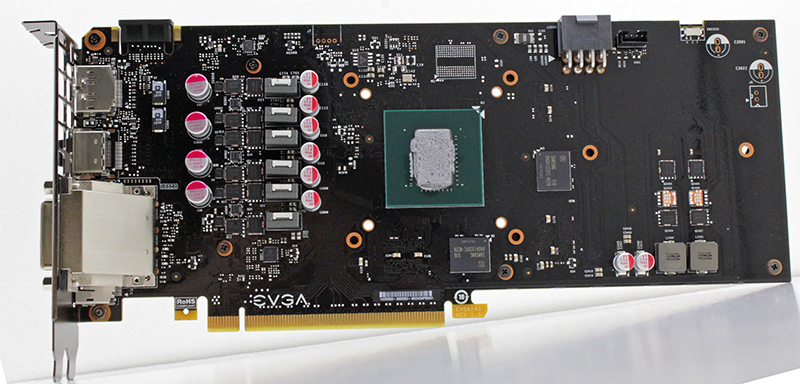
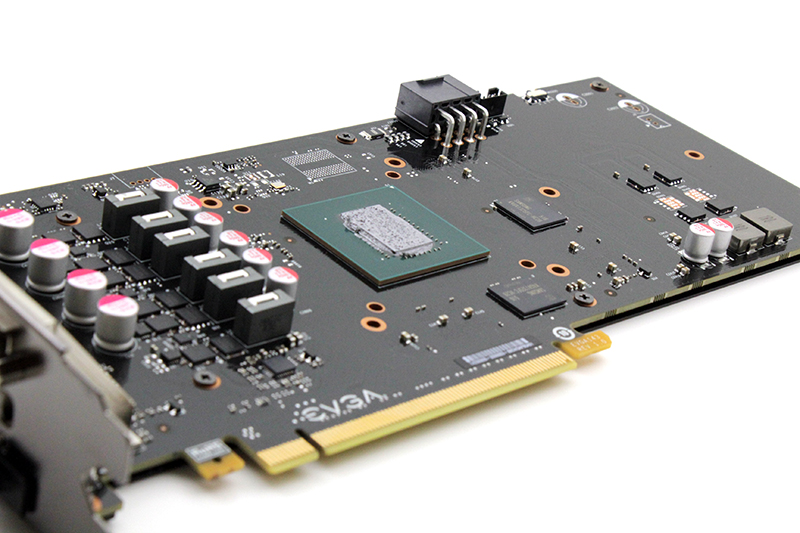
ACX 2.0 cooler on the GTX 950 FTW only deals with heat dissipation from the GPU, while memory and power components are cooled indirectly by airflow.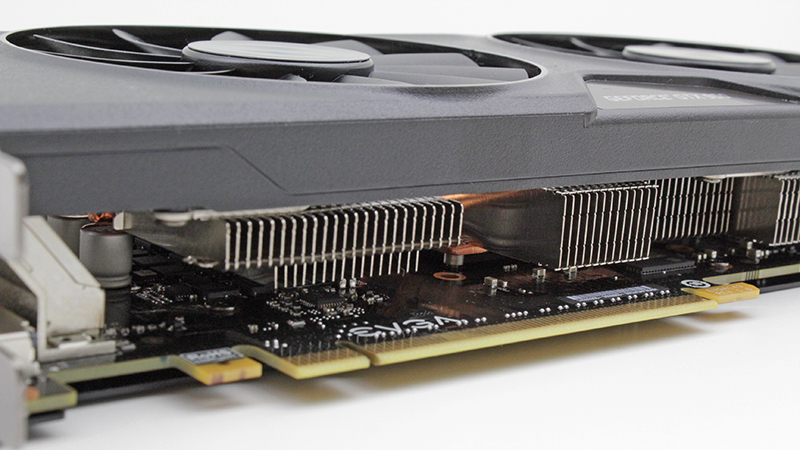
The whole cooler is hold only by four screws in vicinity of the GPU but there are no vibrations or signs of instability.
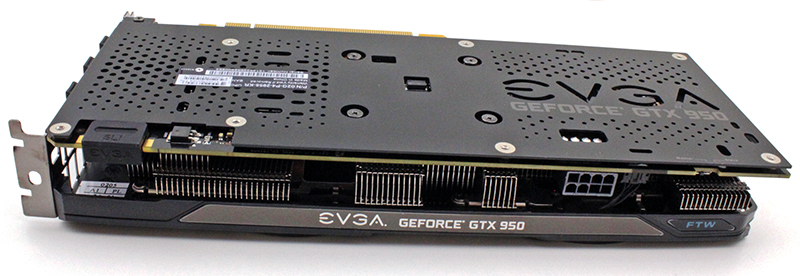
EVGA designed Straight Heat Pipes (SHP) to reduce the GPU temperature by an extra 5°C. According to EVGA internal testing, the triple 8mm SHP offer 6% better heat dissipation than bent heat pipes with reduced thermal resistance. A big copper base covers the small GM206 GPU.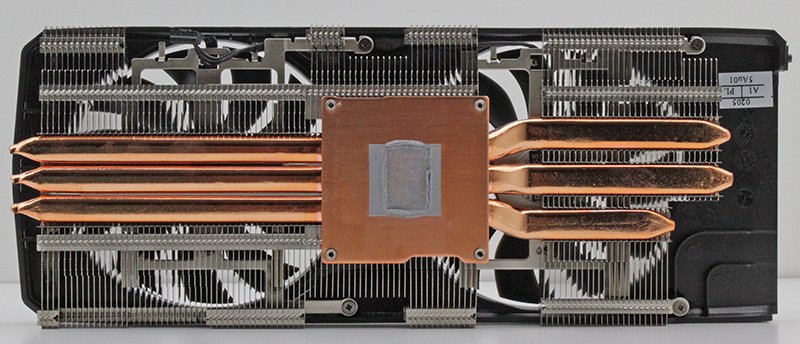
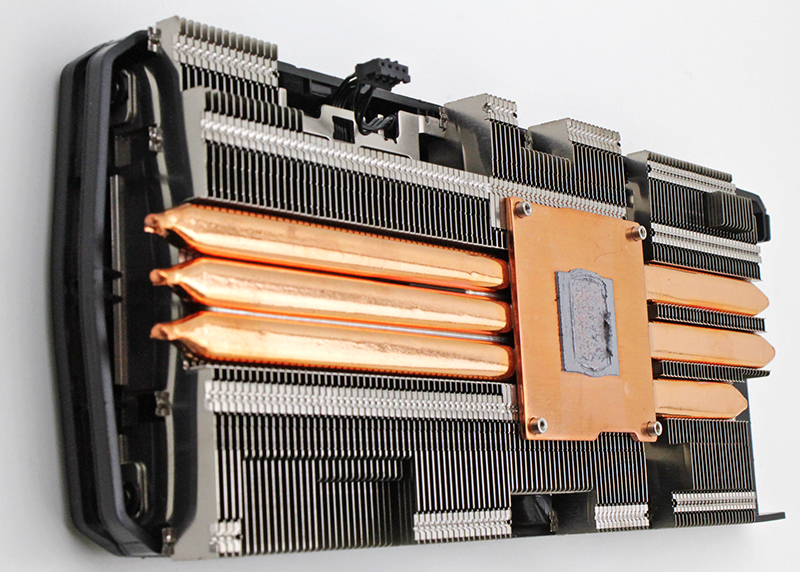
This card is meant for overclocking and QSD (Quick Switch Dual BIOS) allows you to switch to the secondary BIOS with the flick of a switch. The BIOS switch is located close to the PCI power connector. Be aware that changing the vbios does void the warranty, but since the card has a pair of BIOS chips, you can safely modify/flash the slave(secondary) without voiding the warranty.
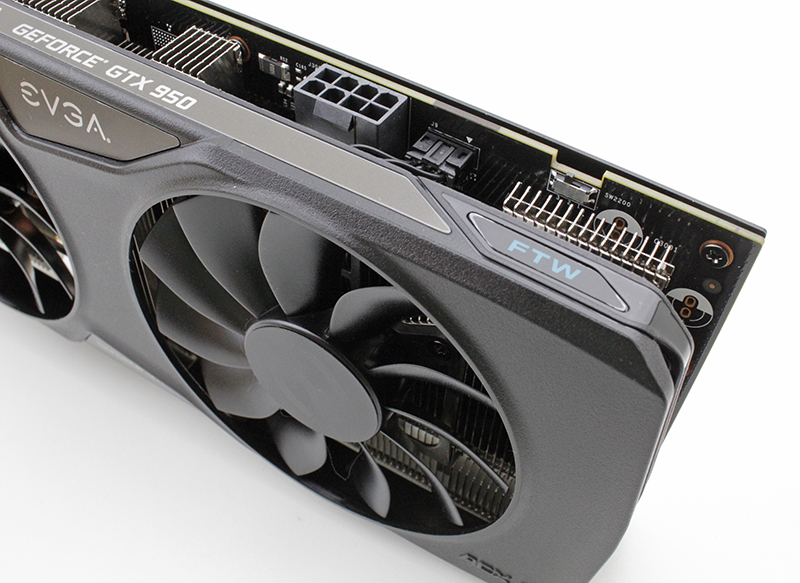
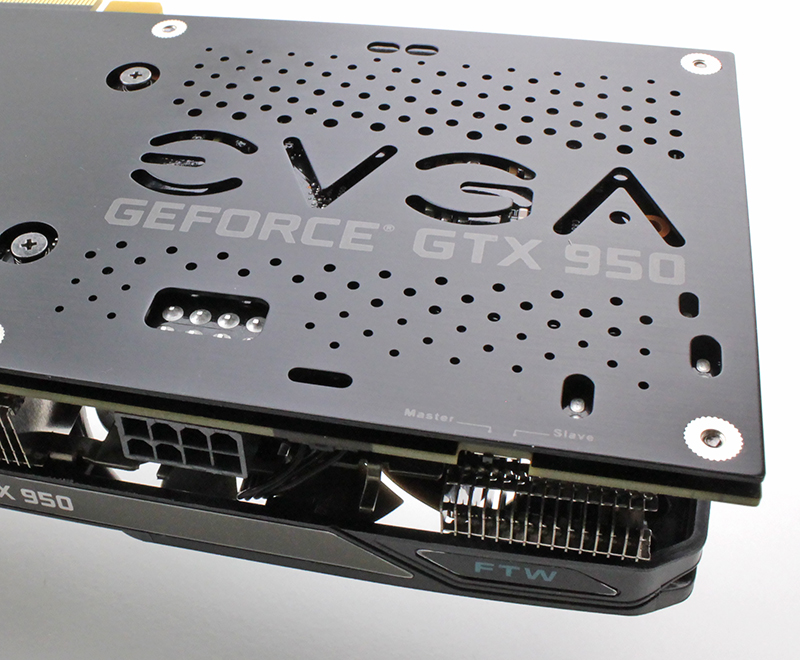
Testbed
Recently we migrated to new Windows 10. We apologise for not including some other cards, especially competing card from AMD in the result tables. We are working hard to update all table results.
Migration was not straightforward and without issues. We tried the windows upgrade and ended-up with some bugs related to Nvidia driver. The Nvidia driver was not shown in Control Panel among other installed programs, however Nvidia Control Panel was accessible and fully working. This issue was solved with an Nvidia driver reinstall.
We could not find a solution for the second, more serious problem. We were not allowed to rise the graphics card memory clock but the GPU overclocked without problems. This issue was present when we upgraded from Windows 8.1 to Windows 10.
A fresh install solved all the problems. We believe that most of our readers will do fresh OS install however, and we advise you to do so.
Windows upgrade may work for the most users, but there is no warranty that every byte will at the right position after upgrade.
Testbed:
- Motherboard: EVGA X99 FTW
- CPU: Intel Core i7 5960K, 4.2GHz (Haswell-E)
- CPU Cooler: Thermalright HR-02
- Memory: 4x4GB Kingston HyperX Predator DDR4 memory Review (HX430C15PBK4/16)
- SSD: Toshiba THNSNJ256GCSU 256GB
- Case: CoolerMaster Cosmos II
- Operating System: Win10 64-bit
Drivers:
- Nvidia 353.62
- Nvidia 355.65

3DMark
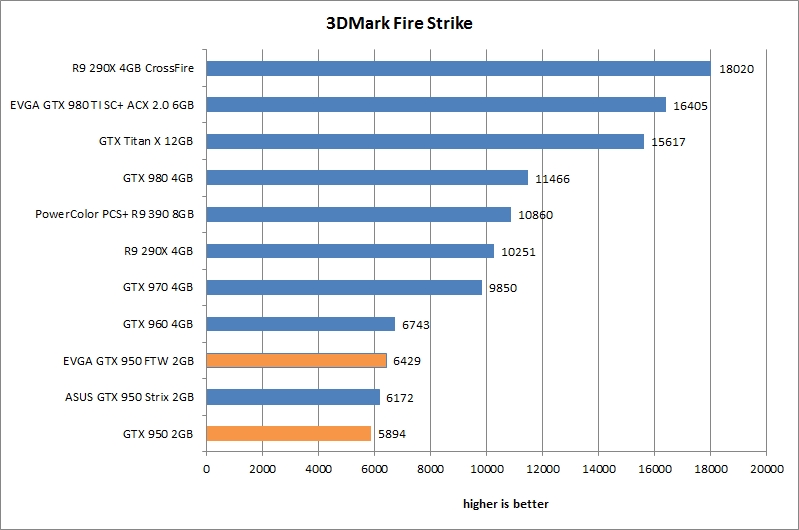
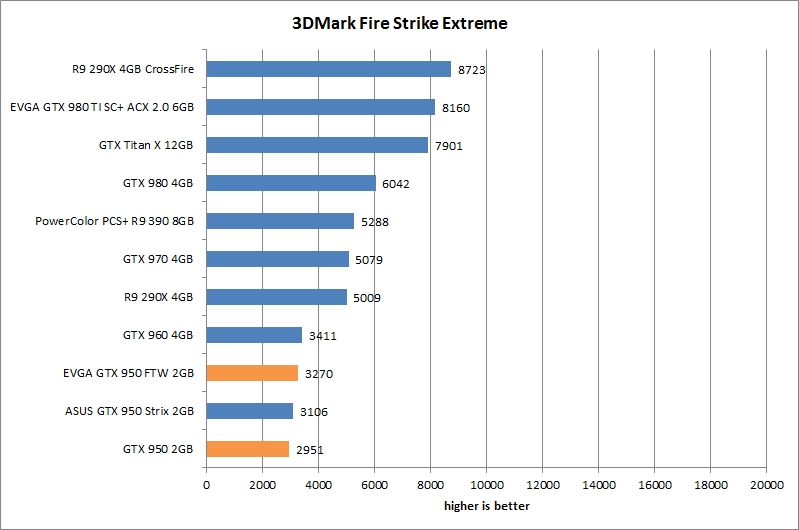
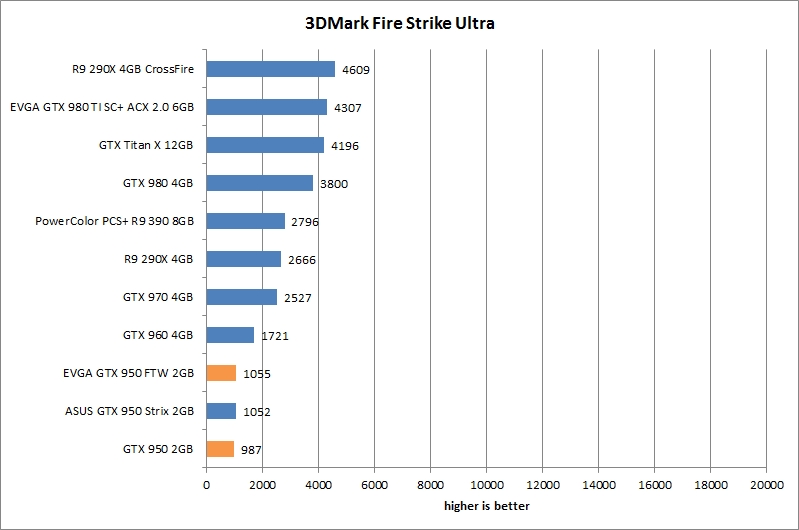
Unigine Heaven
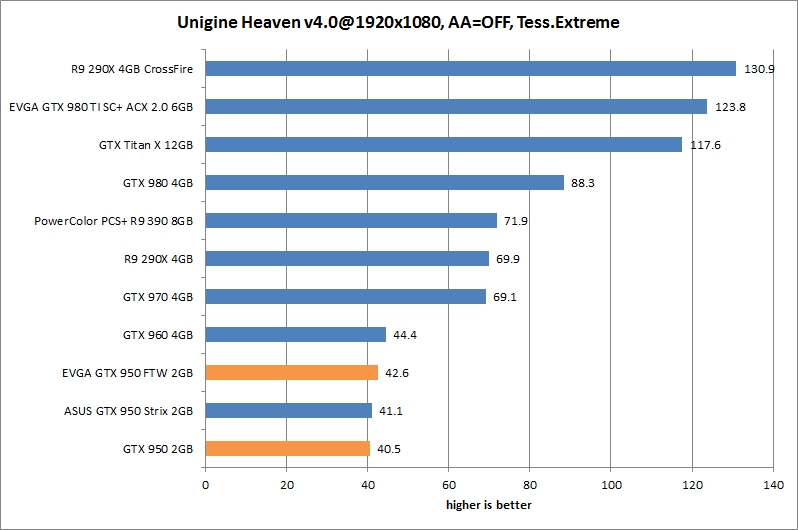

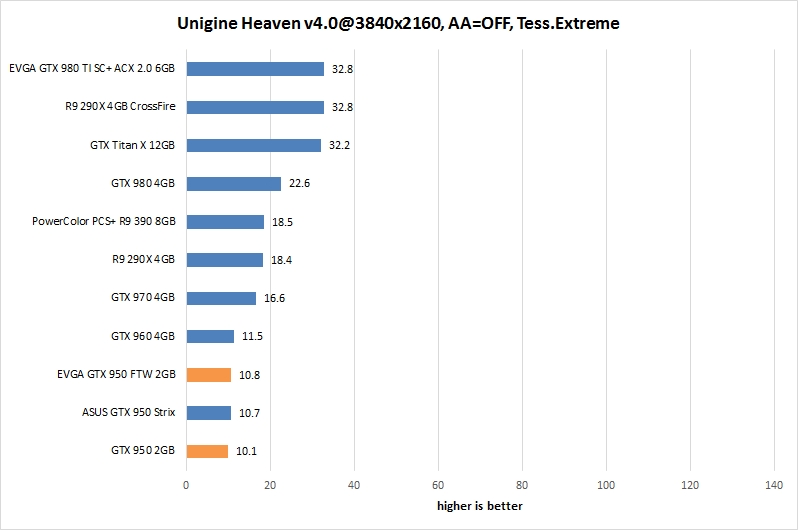
BioShock Infinite
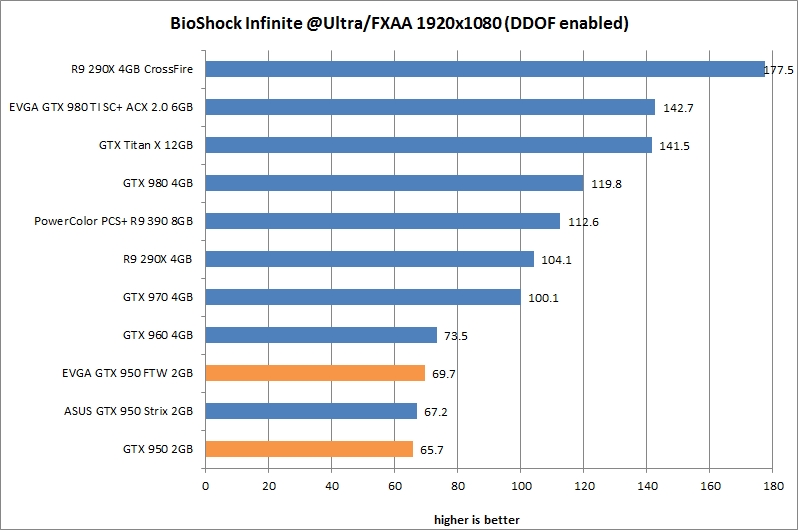
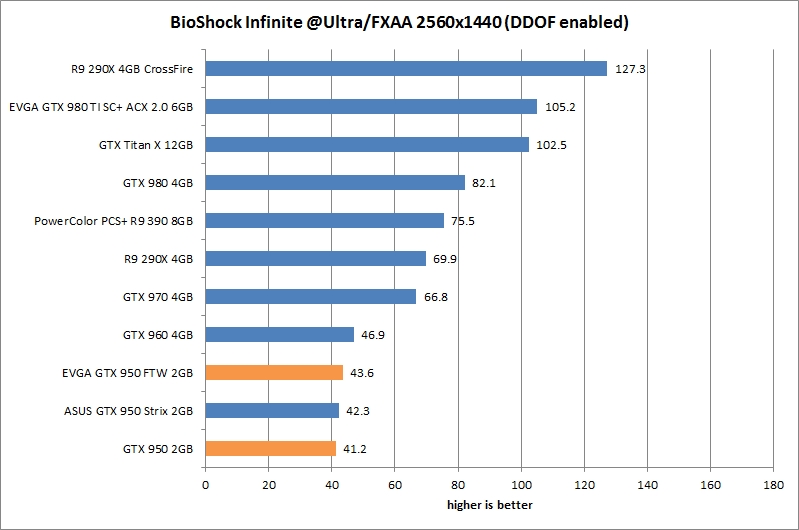
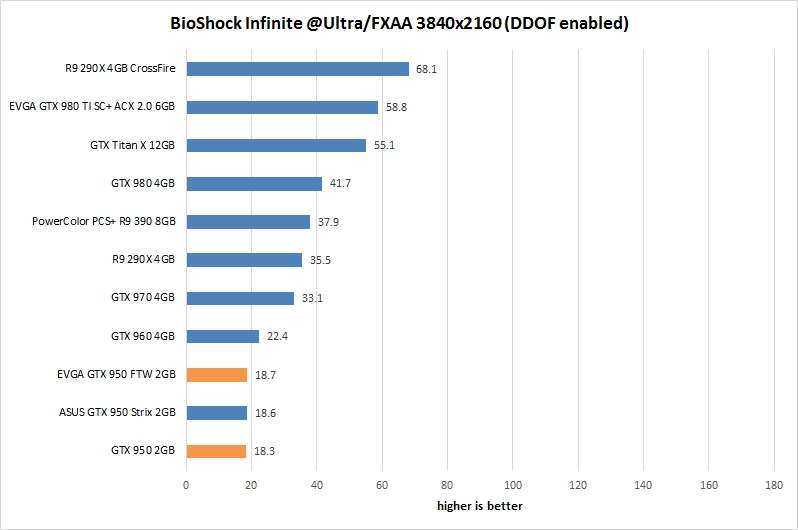
Tomb Raider
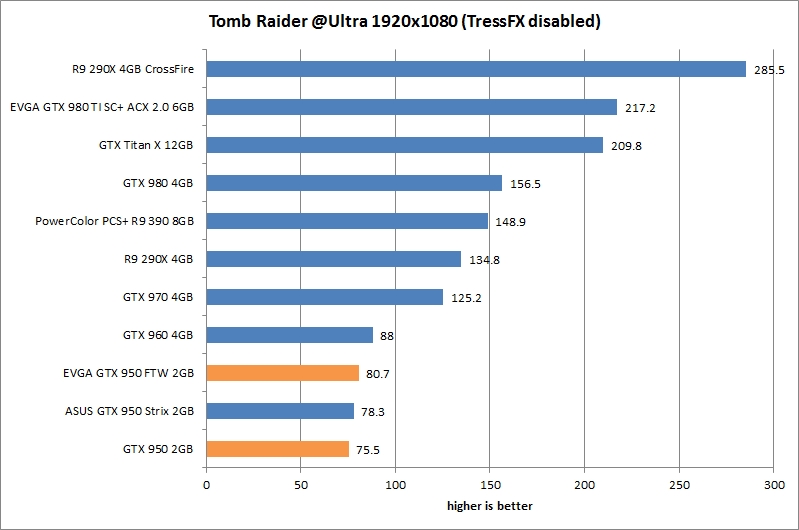

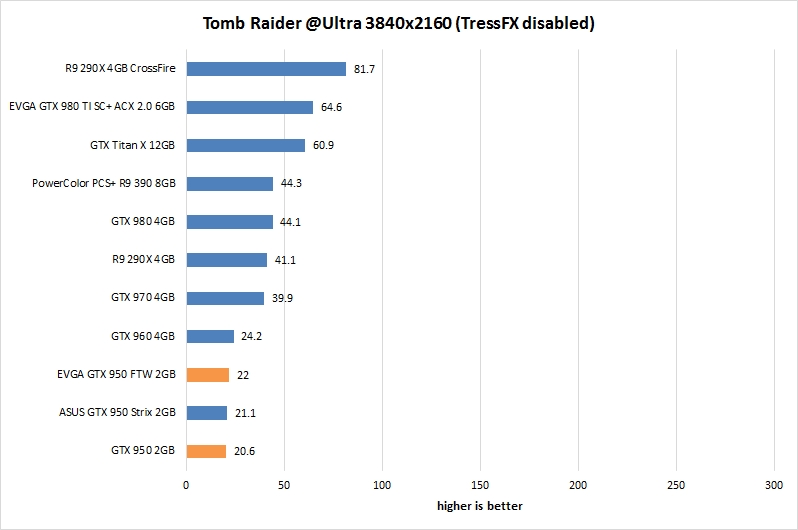
Thief

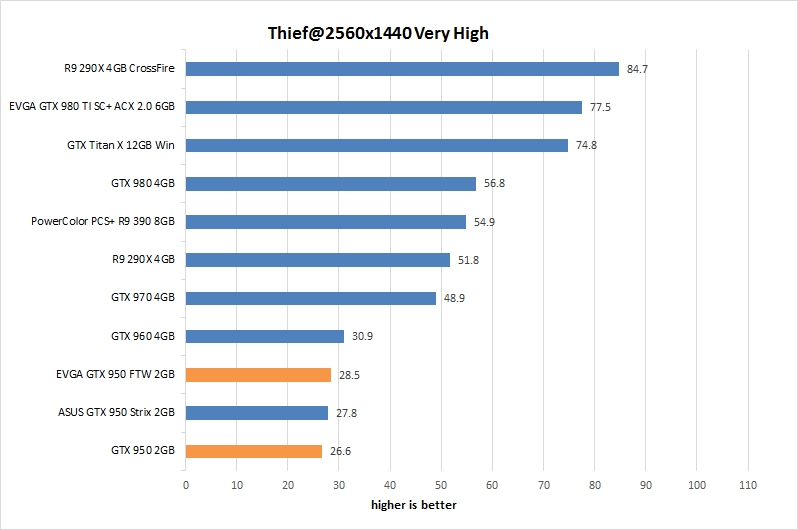
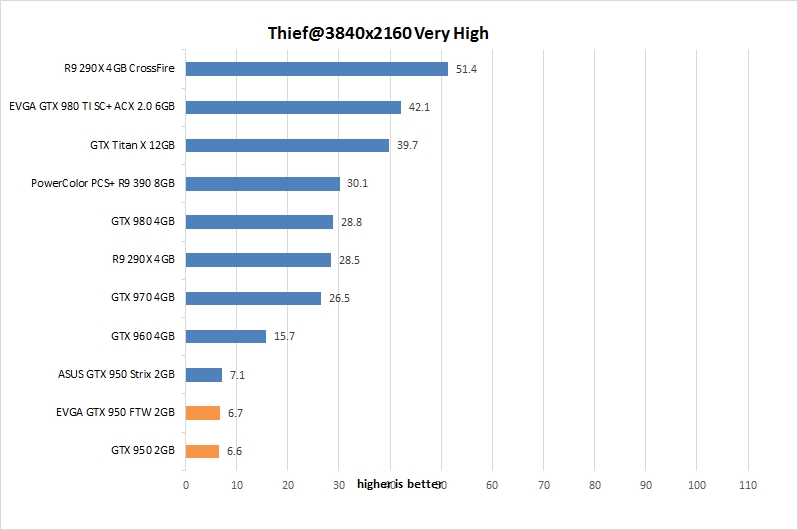
Thermals and Noise
The GTX 950 FTW is a factory overclocked card with bumped up GPU frequencies, yet thanks to the ACX 2.0 cooler it is supposed to be cooler and quieter than the competitive cards. Indeed the GTX 950 FTW fans are almost inaudible in 3D and this time we can confirm there is no coil whine.
The card is silent in idle and during media playback or light gaming. Namely the card turns its fans off when GPU temperature is below 60 degrees Celsius. The screenshot below shows this works in practice. Note how fan RPM reaches zero before the fans are stopped, but this is normal since the fans can not stop rotate immediately.
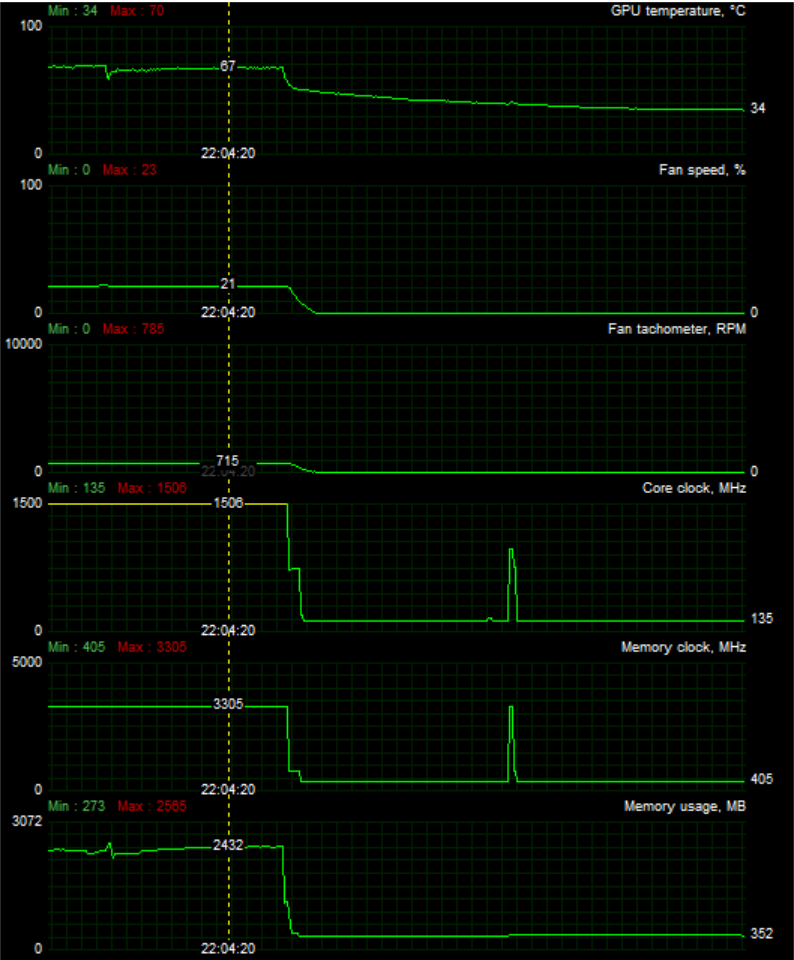
You can use PrecisionX to monitor and control the fan speed.
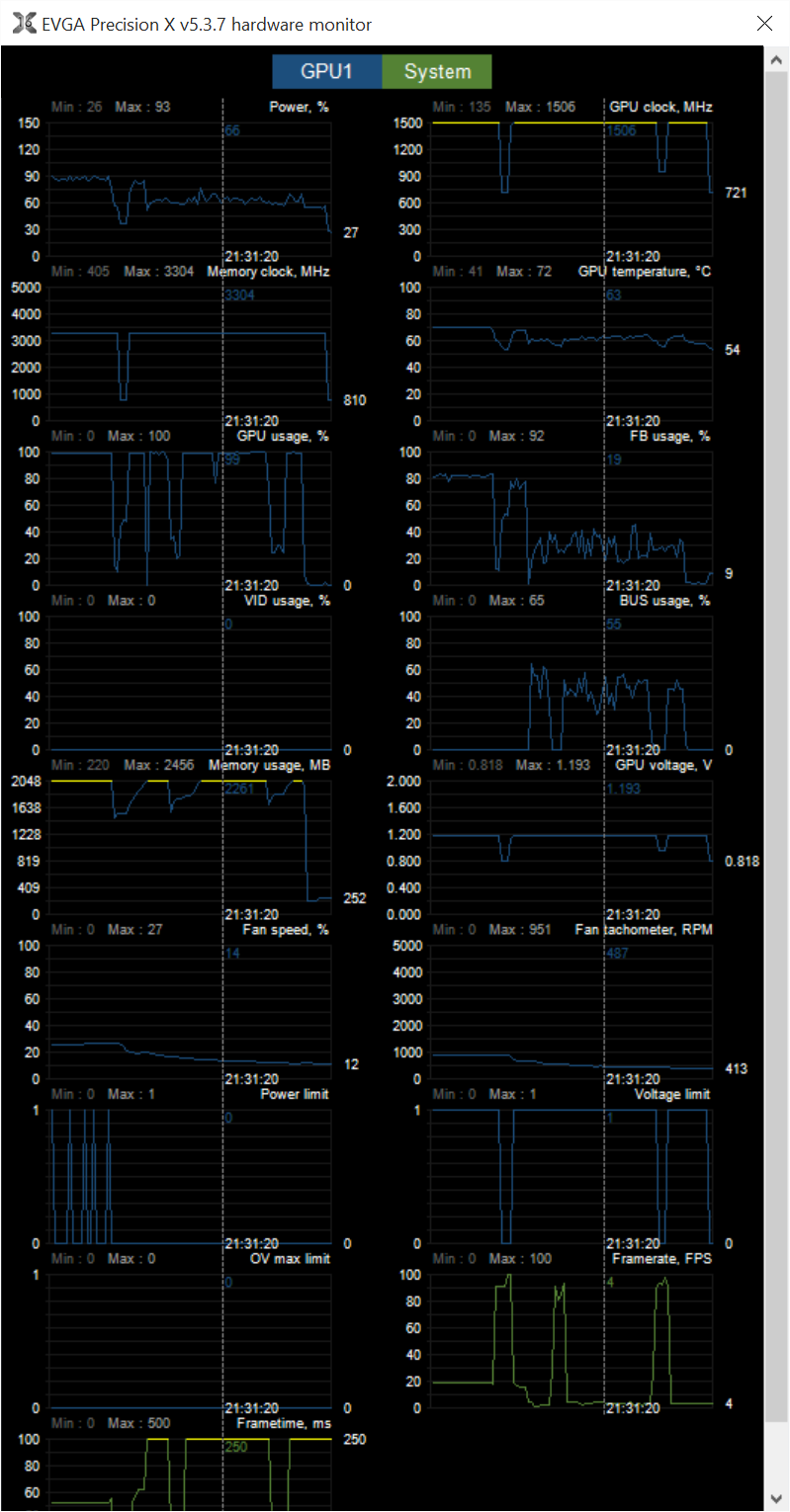
Power Consumption
One of the hallmarks of Maxwell GPUs is efficiency. The Maxwell SM was rebalanced to give each processing block of CUDA cores its own dedicated resources for instruction scheduling and dispatch. This keeps the GPU’s CUDA cores fully utilized more often, improving workload efficiency and reducing wasted power.
The GTX 980, GTX 970, GTX 960 and GTX 950 do not bring a huge performance boost compared to the previous generation, but they prove Maxwell is vastly more efficient than Kepler. The GTX 980 has a TDP of just 165W, GTX 970 has a TDP of just 145W, GTX 960 has TDP of just 120W and GTX 950 has TDP of only 90W. EVGA GTX 950 FTW card is factory overclocked (179MHz for the GPU) and this increases power consumption. We do not have reference card so we don’t know the exact difference in real life conditions, but we compared it to the ASUS GTX 950 Strix. Playing games at 1080p resolution makes no difference in power consumption between the two GTX 950 cards; in some games we measured less in other more power consumption. When we switched to 4K resolution, which is however not a target resolution for the GTX 950, we measured a couple of watts more for the FTW card, probably due to its higher clocks. Compared to the GTX 960 which consumes at maximum about 129W, the GTX 950 FTW card consumes about 8W less.
Overclocking
The Geforce GTX 950 has a fair amount of overclocking headroom. However note that each sample overclocks differently and therefore our results can serve only as guideline for what you can achieve with another GTX 950.
The reference card’s base clock frequency is 1024MHz, with a boost clock of 1188MHz. However, The EVGA GTX 950 FTW base clock frequency is 1203MHz, with a boost clock of 1405MHz, and we measured clocks up to 1506MHz in games. This is already 179MHz overclock for the Base GPU clock and the GPU reached almost its headroom limit. We had two GTX 950 FTW cards and with one card we achieved +50MHz over the GPU factory overclock, while the second card allowed clock increase of only 10MHz. Note that this was achieved by using standard voltage and AUTO fan settings.
Memory overclocking was much healthier and on both card we raised memory clock by 350MHz (1400MHz effective GDDR5). Overal we measured up to 10% performance increase after our overclocking.
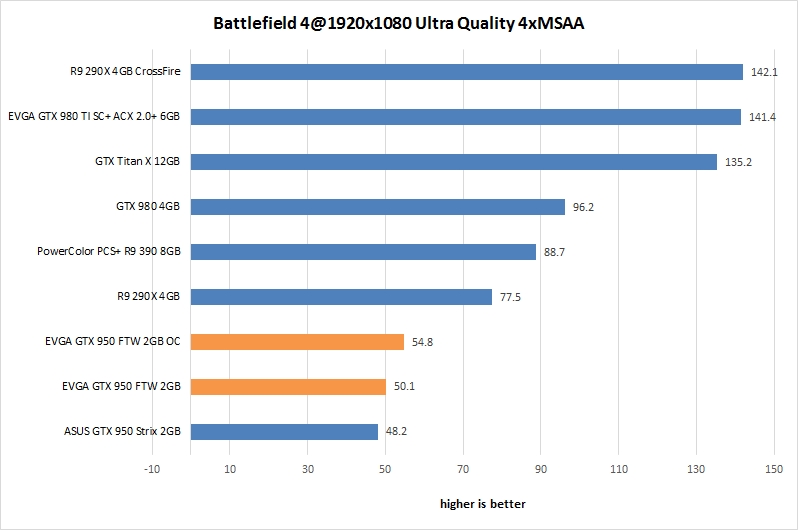
Conclusion
With Geforce GTX 950 graphics card, Nvidia brings the new Maxwell architecture enabled features for gamers on budget. At least we hoped it will be that way. The suggested MSRP including VAT for the GTX 950 is €169 (Germany) while in most other EU countries the prices starts from 179€. This is more than we expected considering the card’s name. Traditionally GTX x50 series was cheaper, for example the GTX 750 Ti was priced at €140.
Anyway the card has power to play most games with high in-game details at 1920x1080 resolution and that is important. You should consider this card if you are upgrading from an older entry level GPU, like GTX 650 for example. The Geforce GTX 950 will even deliver playable frame rates with 4K DSR when playing MOBA games like League of Legends.
The GTX 950 comes with DirectX 12 support and good power efficiency. Many other features are supported like ShadowPlay and GameStream Co-Op which allows gamers to share their favourite gaming moments with the world or with a friends and play with them cooperatively.
EVGA GTX 950 FTW ACX 2.0 graphics card comes with a hefty 179MHz factory overclock which translates into a good 7% performance bump right out of the box. The ACX cooler is almost inaudible in 3D while the card turns its fans off when GPU temperature is below 60 degrees Celsius. This means total silence while watching movies or web surfing.
EVGA showed four different GTX 960 cards and three of them are equipped with the ACX 2.0 cooler, so we recommend to check one of these if you want a silent GTX 950 card. EVGA GTX 950 FTW comes with highest GPU overclock and it features an attractive backplate which is optional on other EVGA cards from the same series. We are only disappointed by its high price, but still we recommend the FTW card if you want top performing GTX 950 card with silent cooler.
EVGA GeForce GTX 950 FTW ACX 2.0 graphics card [Part Number: 02G-P4-2958-KR] has an MSRP of €189.90 (Germany). But we have some good news for gamers in Europe. In Germany, there will also be a €10 Cashback promotion (until 30 September) with participating etailers on both FTW and SC+. Similar deals can be found in Italy and Switzerland. Additional countries/regions may be included in next few days.

